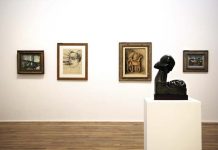The name of the exhibition Registros/Records… is significant. Brings records, traces, marks, fissures… in the body, scalpel marks, authorized and even wanted violations. This is Nazareth. Her body expresses a world where surviving is categorical imperative. Her work is the expression of this force of life. This exhibition accompanied the launch of a book that brings together the work of Nazareth and texts that marked her exhibitions. Registros/Records is an exhibition that carried the story of a life of creation. Or creation as the only possibility of life.
Successive surgical interventions to correct congenital defects have been necessary since she was born. In other exhibitions, the marks on the body have become shocking, seductive works. Dresses built with razor blades and razor blades drives us out and fascinate. The game between the impenetrable (clear reference to Helio Oiticica) and the impossible erotic was a constant theme. The question of the female body has always been a theme for Nazareth. In the last exhibition, the theme is the mourning of his parents, that died five years ago. The ability to work out so atrocious pain through her beautiful production touches.
I wrote the text for the catalog of her 2003 exhibition at Galeria Brito Cimino, when I made the documentary “Gilete Azul”. In this exhibition a huge curtain of razors and razors surrounded the acrylic bed. Now, in this exhibition, the curtains are made from the radiographs that her parents took during the course of the cancer that each lived, with very little time difference. It was when she and her siblings took the ashes of their mother to Paris that they knew that the father had already advanced symptoms of cancer. Nazareth tells how she was attached to her father. In the exhibition at the gallery Kogan Amaro, her father’s work instruments – who was a neurologist – become bronze sculptures. Touching homage where the gestures of a father are eternalized. As in her all exhibitions, there also exists the presence of her body: a sequence of photos that accompany the plastic surgeries she made occupies one of the walls of the gallery. In Nazareth there is a constant rebirth. On another wall, the letter a Scottish surgeon wrote to her father about what should be done, Nazareth still small. A chain is built with the little bracelets that Nazareth used on this course through the procedures. Sensitive soul violated by necessary interventions, now Nazareth chose to take care of her face. This life force has enchanted me since I met her. That’s what led me to do the documentary “Gilete Azul. I bring here a small sample of the text that is in the book that was released in the exhibition Registros / Records:
* Miriam Chnaiderman is a psychoanalyst and filmmaker, produced the documentary Gilete Azul
Inventing bodies and / or unveiling the erotic in disquieting debauchery: the sore spell

It is in our body that we experience the work by Nazareth Pacheco: we are taken by the vertigo of a world that shatters us, spreading viscera in bizarre orgasms between pain and ecstasy. It is our body that is exposed to sharp and sharp objects. It is the very notion of the psychic subject that is questioned, the play of mirrors is reversed, we lose sight of what has constituted us, we become exposed wound. Destructive movement of fields of desire, emptying contours, defrosting mountains. This is the radicalism of Nazareth Pacheco’s work: to establish a flesh-body in the one who looks at her work. And, in so doing, it forces a self-restoration work. In this, several selves become possible, several bodies can happen. Nazareth Pacheco works on the issue of jouissance, that enjoyment that is barred by desire. This implies breaking barriers, a confrontation with limits. Joy is the field of what is not fit in the word, of which it can not be named. Delight has to do with pure intensity, swirling forces. Delight strengthens the barrier of the pleasure principle, and therefore questions the interdict. Nazareth Pacheco proposes a more than desire, a meeting with what originates in eroticism. It transgresses, heading towards a real drive. Contemporary libertinism, the invention of a language that matches meaning and sign. There is no possible metaphor, we are on the level of the real, the passions of the body. And the real is beyond good and evil. The work of Nazareth Pacheco seeks to disalienate our image, always built from a look that looks at us. We are obliged to retake ourselves as subjects of our desires.











